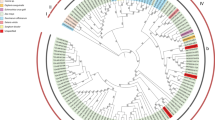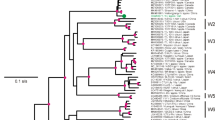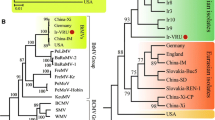Abstract
To enhance the knowledge of recombination as an evolutionary process, 267 accessions retrieved from GenBank were investigated, all belonging to five economically important viruses infecting fruit crops (Plum pox, Apple chlorotic leaf spot, Apple mosaic, Prune dwarf, and Prunus necrotic ringspot viruses). Putative recombinational events were detected in the coat protein (CP)-encoding gene using RECCO and RDP version 3.31β algorithms. Based on RECCO results, all five viruses were shown to contain potential recombination signals in the CP gene. Reconstructed trees with modified topologies were proposed. Furthermore, RECCO performed better than the RDP package in detecting recombination events and exhibiting their evolution rate along the sequences of the five viruses. RDP, however, provided the possible major and minor parents of the recombinants. Thus, the two methods should be considered complementary.





Similar content being viewed by others
References
Adams MJ, Antoniw JF, Beaudoin F (2005) Overview and analysis of the polyprotein cleavage sites in the family Potyviridae. Mol Plant Pathol 6:471–487
Al-Rwahnih M, Saldarelli P, Myrta A, Pallas V, Savino V (2004) Molecular variability of Apple chlorotic leaf spot virus in different hosts and geographical regions. J Plant Pathol 86:117–122
Boni MF, Posada D, Feldman MW (2007) An exact nonparametric method for inferring mosaic structure in sequence triplets. Genetics 176:1035–1047
Boulila M (2007) Phylogeny and genetic recombination of Grapevine fanleaf virus isolates from naturally infected vineyards in Tunisia. Phytopathol Mediterr 46:285–294
Boulila M (2009a) Molecular evidence for recombination in Prunus necrotic ringspot virus. Plant Mol Biol Rep 27:189–198
Boulila M (2009b) Recombination structure and genetic relatedness among members of the family Bromoviridae based on their RNAs 1 and 2 sequence analyses. Virus Genes 38(3):435–444
Bousalem M, Dizery EJP, Fargette D (2000) High genetic diversity, distant phylogenetic relationships and intraspecies recombination events among natural populations of yam mosaic virus: a contribution to understanding potyvirus evolution. J Gen Virol 81:243–255
Candresse T, Cambra M (2006) Causal agent of sharka disease: historical perspective and current status of Plum pox virus strains. EPPO Bull 36:239–246
Cervera MT, Riechmann JL, Martin MT, Garcia JA (1993) 3’-Terminal sequence of the plum pox virus PS and o6 isolates: evidence for RNA recombination within the potyvirus group. J Gen Virol 74:329–334
Chung BYW, Allen Miller W, Atkins JF, Firth AE (2008) An overlapping essential gene in the Potyviridae. Proc Natl Acad Sci USA 105(15):5897–5902
Codoner FM, Elena SF (2008) The promiscuous evolutionary history of the family Bromoviridae. J Gen Virol 89:1739–1747
Domingo E, Holland JJ (1997) RNA virus mutations and fitness for survival. Ann Rev Microbiol 51:151–178
Domingo E, Holland J, Biebricher C, Eigen M (1995) Quasispecies: the concept and the world. In: Gibbs AJ, Calisher CH, Garcia-Arenal F (eds) Molecular basis of virus evolution. Cambridge University Press, Cambridge, pp 181–191
Drake JW, Holland JJ (1999) Mutation rates among RNA viruses. Proc Natl Acad Sci USA 96:13910–13913
Eigen M (1996) On the nature of virus quasispecies. Trends Microbiol 4:216–218
Fonseca F, Neto JD, Martins V, Nolasco G (2005) Genomic variability of Prune dwarf virus as affected by agricultural practice. Arch Virol 150(8):1607–1619
Fraile A, Alonso-Prados JL, Aranda MA, Bernal JJ, Malpica JM, Garcia-Arenal F (1997) Reports about recombination in virus natural populations. J Virol 71:934–940
Gibbs MJ, Armstrong JS, Gibbs AJ (2000) Sister-scanning: a Monte Carlo procedure for assessing signals in recombinant sequences. Bioinformatics 16:573–582
Glasa M, Kudela O, Marie-Jeanne V, Quiot JB (2001) Evidence of naturally occurring recombinant Plum pox virus isolates from Slovakia. Plant Dis 85:920
Glasa M, Marie-Jeanne V, Labonne G, Subr Z, Kudela O, Quiot JB (2002) A natural population of recombinant plum pox virus is viable and competitive under field conditions. Eur J Pant Pathol 108:843–853
Glasa M, Palkovics L, Kominek P, Labonne G, Pittnerova S, Kudela O, Candresse T, Subr Z (2004) Geographically and temporally distant natural recombinant isolates of Plum pox virus (PPV) are genetically very similar and form a unique PPV subgroup. J Gen Virol 85:2671–2681
Glasa M, Paunovic S, Jevromivic D, Myrta A, Pittnerova S, Candresse T (2005) Analysis of recombinant Plum pox virus (PPV) isolates from Serbia confirms genetic homogeneity and supports a regional origin for the PPV-Rec subgroup. Arch Virol 150:2051–2060
Hammond RW (2003) Phylogeny of isolates of Prunus necrotic ringspot virus from the ilarvirus ringtest and identification of group-specific features. Arch Virol 148:1195–1210
Holland JJ, DeLaTorre JC, Steinhauer DA (1992) RNA virus populations as quasispecies. In: Holland JJ (ed) Genetic diversity of RNA viruses. Springer-Verlag, Berlin, pp 1–20
Holmes EC, Worobey M, Rambaut A (1999) Phylogenetic evidence for recombination in Dengue virus. Mol Biol Evol 16:405–409
James D, Glasa M (2006) Causal agent of sharka disease: new and emerging events associated with Plum pox virus characterization. EPPO Bull 36:247–250
Koonin EV, Gorbalenya AE (1989) Evolution of RNA genomes does the high mutation rate necessitate high rate of evolution of virus protein? J Mol Evol 28:524–527
Kumar S, Nei M, Dudley J, Tamura K (2008) Mega: a biologist-centric software for evolutionary analysis of DNA and protein sequences. Brief Bioinform 9(4):299–306
Larkin MA, Blackshileds G, Brown NP, Chenna R, McGettigan PA, McWilliam H, Valentin F, Wallace IM, Wilm A, Lopez R, Thompson JD, Gibson TJ, Higgins DG (2007) Clustal W and Clustal X version 2.0. Bioinformatics 23(21):2947–2948
Legg JP, Thresh JM (2000) Cassava mosaic virus disease in East Africa: a dynamic disease in a changing environment. Virus Res 71:135–149
Lopez-Moya JJ, Fernandez-Fernandez MR, Cambra M, Garcia JA (2000) Biotechnological aspects of Plum pox virus. J Biotechnol 76:121–136
Martin D, Rybicki E (2000) RDP: detection of recombination amongst aligned sequences. Bioinformatics 16:562–563
Martin DP, Posada D, Crandall KA, Williamson C (2005a) A modified bootscan algorithm for automated identification of recombination sequences and recombination breakpoints. AIDS Res Hum Retroviruses 21:98–102
Martin DP, Williamson C, Posada D (2005b) RDP2: recombination detection and analysis from sequence alignments. Bioinformatics 21:260–262
Matic S, Al-Rwahnih M, Myrta A (2006) Diversity of Plum pox virus isolates in Bosnia and Herzegovina. Plant Pathol 55:11–17
Maydt J, Lengauer T (2006) Recco: recombination analysis using cost optimization. Bioinformatics 22(9):1064–1071
Merits A, Rajamaki ML, Lindholm P, Runeberg-Roos P, Kekarainen T, Puustinen P, Makelainen K, Valkonen JPT, Saarma M (2002) Proteolytic processing of potyviral proteins and polyprotein processing intermediates in insect and plant cells. J Gen Virol 83:1211–1221
Monci F, Sanchez-Campos S, Navas-Castillo J, Moriones E (2002) A natural recombinant between the geminiviruses tomato yellow leaf curl Sardinia virus and tomato yellow leaf curl virus exhibits a novel pathogenic phenotype and is becoming prevalent in Spanish populations. Virology 303:317–326
Myrta A, Al-Rwahnih M, Savino V (2005) Presence of a Plum pox virus recombinant in Apulia (Southern Italy). J Plant Pathol 87:119–122
Ohshima K, Yamaguchi Y, Hirota R, Hamamoto T, Tomimura K, Tan Z, Sano T, Azuhata F, Walsh JA, Fletcher J, Chen J, Gera A, Gibbs A (2002) Molecular evolution of Turnip mosaic virus: evidence of host adaptation, genetic recombination and geographical spread. J Gen Virol 83:1511–1521
Padidam M, Sawyer S, Fauquet CM (1999) Possible emergence of new geminiviruses by frequent recombination. Virology 265:218–225
Petrzik K (2005) Capsid protein sequence gene analysis of Apple mosaic virus infecting pears. Eur J Plant Pathol 111:355–360
Posada D, Crandall K (2001) Evaluation of methods for detecting recombination from DNA sequences Computer simulation. Proc Natl Acad Sci USA 98:13757–13762
Riechmann JL, Lain S, Garcia JA (1992) Highlights and prospects of potyvirus molecular biology. J Gen Virol 73:1–16
Roossinck MJ (1997) Mechanisms of plant virus evolution. Annu Rev Phytopathol 35:191–209
Rubio L, Ayllon MA, Kong P, Fernandez A, Polek M, Guerri J, Moreno P, Falk BW (2001) Genetic variation of Citrus tristeza virus isolates from California and Spain: evidence for mixed infections and recombination. J Virol 75(17):8054–8062
Salvador B, Garcia JA, Simon-Mateo C (2006) Causal agent of sharka disease: Plum pox virus genome and function of gene products. EPPO Bull 36:229–238
Sato K, Yoshikawa N, Takahashi T (1993) Complete nucleotide sequence of the genome of an apple isolate of Apple chlorotic leaf spot virus. J Gen Virol 74:1927–1931
Smith JM (1992) Analyzing the mosaic structure of genes. J Mol Evol 34:126–129
Tajima F (1989) Statistical method for testing the neutral mutation hypothesis by DNA polymorphism. Genetics 123:585–595
Tomitaka Y, Ohshima K (2006) A phylogeographical study of the Turnip mosaic virus population in East Asia reveals an ‘emergent’ lineage in Japan. Mol Ecol 15:4437–4457
Urcuqui-Inchima S, Haenni AL, Bernardi F (2001) Potyvirus proteins: a wealth of functions. Virus Res 74:157–175
Van Regenmortel MHV, Fauquet CM, Bishop DHL, Carstens EB, Estes MK, Lemon SM, McGeoch DJ, Maniloff J, Mayo MA, Pringle CR, Wickner RB (2000) Virus taxonomy. Classification and nomenclature of viruses. Seventh ICTV report. Academic Press, San Diego
Weiller GF (1998) Phylogenetic profiles: a graphical method for detecting genetic recombination in homologous sequences. Mol Biol Evol 15:326–335
Yaegashi H, Takahashi T, Isogai M, Kobori T, Ohki S, Yoshikawa N (2007) Apple chlorotic leaf spot virus 50 kDa movement protein acts as a suppressor of systemic silencing without interfering with local silencing in Nicotiana benthamiana. J Gen Virol 88:316–324
Yoshikawa N, Takahashi T (1988) Properties of RNAs and proteins of apple stem grooving and apple chlorotic leaf spot viruses. J Gen Virol 69:241–245
Zimmern D (1988) Evolution of RNA viruses. In: Holland JJ, Domingo ER, Ahlquist P (eds) RNA genetics. CRC Press, Boca Raton, pp 211–240
Author information
Authors and Affiliations
Corresponding author
Rights and permissions
About this article
Cite this article
Boulila, M. Putative Recombination Events and Evolutionary History of Five Economically Important Viruses of Fruit Trees Based on Coat Protein-Encoding Gene Sequence Analysis. Biochem Genet 48, 357–375 (2010). https://doi.org/10.1007/s10528-009-9317-4
Received:
Accepted:
Published:
Issue Date:
DOI: https://doi.org/10.1007/s10528-009-9317-4




